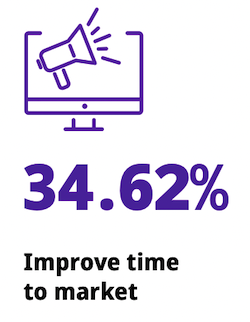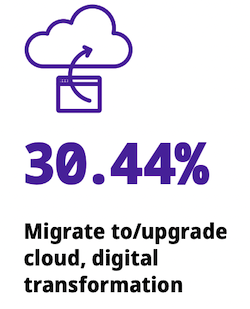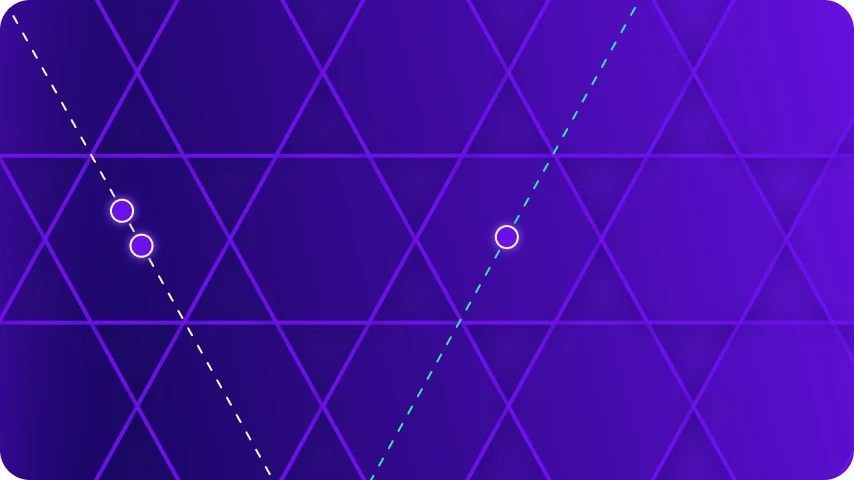June 1, 2023
A pesquisa State of Enterprise Integration da Digibeefoi realizada no início deste ano, reunindo opiniões e contribuições de mil CTOs, CIOs, arquitetos de sistemas e desenvolvedores web na América do Norte.
Os dados da pesquisa oferecem insights reveladores sobre o estado da integração em diversos setores. Neste blog post, exploramos algumas descobertas específicas para o varejo, um dos três relatórios setoriais publicados.
Um insight único e muito interessante é o “porquê” por trás da integração empresarial. Com base nas respostas dos varejistas, os objetivos de maior valor para a integração são os seguintes:
- Melhorar o time to market
- Migrar para a nuvem ou modernizar a infraestrutura, transformação digital
- Habilitar automação e inteligência artificial
Um tema conecta esses três objetivos: investimento proativo em inovação para competir melhor. Está claro que os varejistas não podem se dar ao luxo de ser complacentes no cenário atual em constante mudança. E, embora a integração tradicionalmente não tenha sido vista como uma tecnologia estratégica, os líderes verdadeiramente visionários percebem como ela pode viabilizar inovações cruciais. Essa visão está refletida nesses objetivos.
>> Agende uma demonstração personalizada com nossa equipe de especialistas e veja como o iPaaS da Digibee trará eficiência ao seu negócio.
1. Melhore o time to market
Quase 35% dos respondentes classificam o time to market como o principal objetivo de integração empresarial no varejo. Isso faz sentido ao considerar os benefícios significativos para o negócio, como maior participação de mercado, aumento da receita e uma vantagem competitiva relevante.
 Quando um varejista consegue reduzir o time to market, o negócio é recompensado com mais dias de vendas. Isso é especialmente importante no contexto do e-commerce, onde os clientes que compram online esperam encontrar os produtos e serviços mais novos ao alcance de um clique. E, quando não encontram, é fácil mudar para outro varejista online.
Quando um varejista consegue reduzir o time to market, o negócio é recompensado com mais dias de vendas. Isso é especialmente importante no contexto do e-commerce, onde os clientes que compram online esperam encontrar os produtos e serviços mais novos ao alcance de um clique. E, quando não encontram, é fácil mudar para outro varejista online.
No entanto, ser o primeiro no mercado é apenas metade da equação. O produto ou serviço que você entrega aos seus clientes também é fundamental. Análises de dados precisas – especialmente dados em tempo real – são essenciais para atender (e até superar) as expectativas dos clientes. As empresas podem alcançar até 70% de participação no mercado quando conseguem ser as primeiras a lançar um novo produto.
Melhorar o time to market no varejo está diretamente relacionado a ganhos de eficiência em toda a organização. Cadeias de suprimentos otimizadas, análises de dados em tempo real e integração de e-commerce com aplicações e sistemas adjacentes. A transformação digital no varejo é essencial para esses avanços, e a integração empresarial é a base sobre a qual tudo isso é construído.

Sem um ambiente verdadeiramente conectado, os varejistas não têm insights para entender o que está funcionando, onde melhorias são necessárias – e, mais importante, avaliar em tempo real a qualidade das experiências que oferecem aos clientes.
Relatório sobre o estado da integração empresarial no varejo
2. A nuvem e a transformação digital
O segundo objetivo de integração mais importante para os varejistas é a nuvem e a transformação digital.
 Dada a velocidade da inovação no varejo, esse resultado não é surpreendente. Nos últimos anos, assistimos à adoção rápida de algumas tecnologias incríveis, como compras digitais e personalizadas, checkouts automatizados e melhorias na forma como os sistemas de inventário são gerenciados e otimizados. A transformação digital – e, especialmente, a nuvem – possibilitou todos esses avanços.
Dada a velocidade da inovação no varejo, esse resultado não é surpreendente. Nos últimos anos, assistimos à adoção rápida de algumas tecnologias incríveis, como compras digitais e personalizadas, checkouts automatizados e melhorias na forma como os sistemas de inventário são gerenciados e otimizados. A transformação digital – e, especialmente, a nuvem – possibilitou todos esses avanços.
Hoje, o mercado de nuvem no varejo na América do Norte deve crescer a uma impressionante taxa composta de CAGR de 4.56%, para uma avaliação de $ 109.98 bilhões de dólares de 2023-2030.
Com tantas oportunidades, não é surpresa que empresas estejam aderindo à transformação digital no varejo em números recordes, com a maioria buscando elevar a experiência do cliente (CX) que entregam. Já não é um diferencial; uma CX personalizada e omnichannel é essencial para a maioria dos varejistas.
Para evoluir, os varejistas precisam migrar para uma arquitetura de tecnologia componível, permitindo que se adaptem e adotem rapidamente novas tecnologias conforme necessário, algo inviável com plataformas monolíticas tradicionais.
A integração empresarial conecta o antigo ao novo, unindo todos os diferentes sistemas e aplicações na pilha de tecnologia do varejo, promovendo agilidade e flexibilidade em um setor onde a mudança é constante.
3. Habilitar a automação e a Inteligência Artificial
Os varejistas classificaram automação e IA como o terceiro item mais importante em sua lista de objetivos de integração, um desdobramento natural após a implementação de iniciativas de nuvem e transformação digital.
 A prioridade dada à IA reflete-se nos números globais do mercado de varejo, onde se espera que o setor alcance aproximadamente 45.74 bilhões de dólares até 2032, com um crescimento anual composto (CAGR) estimado em 18.45% entre 2023 e 2032..
A prioridade dada à IA reflete-se nos números globais do mercado de varejo, onde se espera que o setor alcance aproximadamente 45.74 bilhões de dólares até 2032, com um crescimento anual composto (CAGR) estimado em 18.45% entre 2023 e 2032..
Quando consideramos os volumes de dados gerados pelo comércio eletrônico digital, a IA torna-se indispensável. Com IA, os varejistas conseguem organizar e analisar dados em tempo real de diversas fontes (dados de e-commerce, sistemas ERP de varejo, marketplaces, informações de clientes e concorrentes, entre outros).
Os resultados falam por si só. Insights de dados que possibilitam previsões de demanda incrivelmente precisas para melhorar a gestão de inventário; a detecção de mudanças iniciais nos comportamentos de mercado e consumidores; e, como tudo no varejo se conecta à experiência do cliente (CX), dados em tempo real que otimizam as interações com os clientes.
A IA está ajudando os varejistas a construir sistemas interativos que simplificam a comunicação com o cliente ao longo de toda a jornada de compra. Isso melhora a qualidade da personalização e o engajamento do cliente.
Forbes
O futuro do varejo: quatro maneiras de a indústria utilizar a IA
O acesso em tempo real a históricos de pedidos e perfis de clientes precisos, chatbots de e-commerce, rastreamento de atividades online e em lojas físicas, uma experiência de checkout aprimorada e até o posicionamento de produtos são otimizados com a IA.
A IA também viabiliza a automação, uma capacidade valiosa que oferece benefícios significativos em toda a operação de varejo. Todos os avanços mencionados na seção anterior sobre transformação digital anteriormente dependiam de humanos, resultando em trabalho demorado e frequentemente sujeito a erros. A IA libera os funcionários dessas tarefas repetitivas, aumentando a precisão e a agilidade.
Alcance seus objetivos de negócio com o iPaaS da Digibee
A tecnologia de plataforma de integração como serviço (iPaaS) low-code e nativa em nuvem da Digibee permite conectar todos os pontos (e a infraestrutura de TI) para ajudá-lo a alcançar seus objetivos de transformação digital.
Baixe o relatório Digibee State of Enterprise Integration for Retail e tenha uma visão aprofundada de todos os dados. Entenda como seus pares estão avançando e analise tendências e observações ano a ano para orientar sua estratégia de integração.








